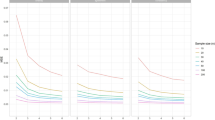Abstract
The adaptive group sequential design of Lehmacher and Wassmer allows fully flexible redetermination of sample size after each of a predetermined number of interim looks. Study 02CLLIII, a large, randomized, multicenter trial in chronic lymphocytic leukemia, was based on this approach, with five planned analyses. The study terminated for efficacy at the third interim analysis. While it was clear how statistical significance was to be determined, calculations of proper P values as well as point and interval estimates turned out to be much less straightforward. We extend existing analysis approaches to the stratified binary and time-to-event data from this trial, investigate the properties of the estimators for the primary endpoint, and highlight remaining issues with full statistical inference after such a design. In conclusion, the flexibility offered by the adaptive features renders statistical inference more difficult and less precise. We believe that there are situations where it may be worth paying this price.
Similar content being viewed by others
References
Pocock SJ. Clinical Trials: A Practical Approach. New York: Wiley; 1983.
Lan KKG, DeMets DL. Discrete sequential boundaries for clinical trials. Biomeirika. 1983;70:659–663.
Jennison C, Turnbull BW. Group Sequential Methods With Applications to Clinical Trials. Boca Raton, FL: Chapman & Hall/CRC; 2000.
Proschan MA, Hunsberger SA. Designed extension of studies based on conditional power. Biometrics. 1995;51:1315–1324.
Lehmacher W. Wassmer G. Adaptive sample size calculations in group sequential trials. Biometrics. 1999;55:1286–1290.
Knauf WU, Lissichkov T. Aldaoud A. et al. Phase III randomized study of bendamustine versus chlorambucil in previously untreated patients with chronic lymphocytic leukemia. J Clin Oncol. 2009;27:4378–4384.
Fleming TR, Richardson BA. Some design issues in microbicide HIV prevention trials. J Infect Dis. 2004;190:666–674.
Insightful. S+ SeqTrial 2 User’s Guide. Insightful Corp.; 2002.
Whitehead J. On the bias of maximum likelihood estimation following a sequential test. Biometrika. 1986;73: 573–581.
Emerson SS, Kittelson JM. A computationally simpler algorithm for the UMVUE of a normal mean following a group sequential design. Biometrics. 1997;53:365–369.
Coburger S, Wassmer G. Conditional point estimation in adaptive group sequential test designs. Biometric J. 2001;43:821–833.
Wright PS. Adjusted P-values for simultaneous inference. Biometrics. 1992;48:1005–1013.
Wassmer G. Planning and analyzing adaptive group sequential survival trials. Biometric J. 2006; 48:714–729.
Cytel Inc. East 5 (v5.2). 2008.
Lan KK, Wittes J. The B-value: a tool for monitoring data. Biometrics. 1988;44:579–585.
Tsiatis AA. The asymptotic joint distribution of the efficient scores test for the proportional hazards model calculated over time. Biometrika, 1981;68:311–315.
Jahn-Eimermacher A, Ingel K. Adaptive trial design: a general methodology for censored time to event data. Contemp Clin Trials. 2009;30: 171–177.
Marubini E, Valsecchi MG. Analysing Survival Data From Clinical Trials and Observational Studies. Chichester, UK: Wiley; 1995.
Bauer P, Koenig F. The reassessment of trial perspectives from interim data—a critical view. Stat Med. 2006;25:23– 36.
Armitage P. McPherson CK, Rowe BC. Repeated significance tests on accumulating data. J R Stat Soc A. 1969;132:235–244.
Brannath W, Posch M, Bauer P. Recursive combination tests. J Am Stat Assoc. 2002;97: 236–243.
Brannath W, Mehta CR, Posch M. Exact confidence bounds following adaptive group sequential tests. Biometrics. 2009;65:539–546.
Brannath W, Koenig F, Bauer P. Estimation in confirmatory adaptive designs with treatment selection. Adaptive Trials 2008, Barcelona.
Tsiatis AA, Mehta G. On the inefficiency of the adaptive design for monitoring clinical trials. Biometrika. 2003;90: 367–387.
Jennison C, Turnbull BW. Efficient group sequential designs when there are several effect sizes under consideration. Stat Med. 2006;25: 917–932.
Jennison C. Critical appraisal of adaptive methods. Adaptive Trials 2008, Barcelona.
Lee PM. Bayesian Statistics: An Introduction. 2nd ed. London: Arnold; 1997.
Cook TD, Benner RJ, Fisher MR. The WIZARD trial as a case study of flexible clinical trial design. Drug Inf J. 2006;40:345–353.
Lan KKG, DeMets DL. Changing frequency of interim analysis in sequential monitoring. Biometrics. 1989;45:1017–1020.
Koch CG, Amara IA, Stokes ME, Uryniak TJ. Categorical data analysis. In: Berry DA (ed.). Statistical Methodology in the Pharmaceutical Sciences. New York: Marcel Decker; 1990.
Author information
Authors and Affiliations
Corresponding author
Rights and permissions
About this article
Cite this article
Tremmel, L.T. Statistical Inference after an Adaptive Group Sequential Design: A Case Study. Ther Innov Regul Sci 44, 589–598 (2010). https://doi.org/10.1177/009286151004400506
Accepted:
Published:
Issue Date:
DOI: https://doi.org/10.1177/009286151004400506




